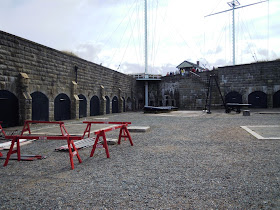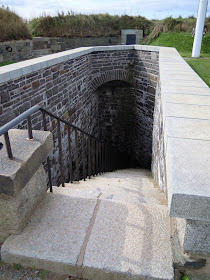Although it is commonly known as 'The Halifax Citadel', the fortress that dominates Halifax, Nova Scotia is officially known as Fort George. The site occupied by the current fortress – Citadel Hill – was previously fortified with a three-storey wooden octagonal blockhouse and gun battery, and it served as part of the defences of Halifax until it was replaced during the early nineteenth century.
The current fortress (or citadel) follows the traditional star-shaped design. Construction began in 1828 and was completed in 1856. The main walls are constructed of masonry although some of the buildings and later additions are built of other materials.
The fortress was garrisoned by the British Army until 1906, after which it was handed over to the Canadian Army. They used it throughout the First and Second World Wars, and during the latter war Fort George was used as a barracks and as the coordination centre for the Halifax's anti-aircraft defences. Once the Second World War was over Citadel Hill and Fort George were designated a Canadian National Historic Site. It has since been restored to how it looked during the mid-Victorian period. Fort George is 'garrisoned' by re-enactors who portray (and interpret for visitors) the sort of life experienced by the soldiers of the 78th (Highlanders) Regiment of Foot (the Ross-shire Buffs) and Third Brigade, Royal Artillery, in 1869.
When we visited Fort George (The Halifax Citadel) we were met at the entrance by a re-enactor who was dressed as a private in the 78th Highlanders ...
... and mighty fine he looked too!
We passed through the narrow entrance to the fortress ...
... and out onto the parade ground. The following photograph shows the Southeast Salient as seen from the Redan.
The Southeast Salient has steps leading up to the Signal Masts and the ramparts on top of the curtain wall.
The parade ground is dominated by the main building inside the fortress, the Cavalier Building.
The following photograph shows the Northeast Salient and gives some impression as to the size of the parade ground.
The ditch between the curtain wall (seen on the right of the following photograph) and the musket gallery (seen on the left) would have been a veritable 'killing ground' for any attacker.
The following photograph shows the parade ground as seen from the ramparts on top of the curtain wall near the Signal Masts.
Amongst the old weaponry on show on the ramparts was a land service mortar.
At various points around the ramparts there are stairways that lead down to protected passages. These run through the ramparts to sally ports that give access to the musket gallery and also to the magazines.
When it was first built the Halifax Citadel was armed with 32-punder smoothbore cannons. These were mounted on wooden swivelling carriages that fired through embrasures in the parapet.
The following photograph shows the parade ground and entrance to the Halifax Citadel as seen from the southern rampart.
The following photograph shows the inside of the Halifax Citadel as seen from the western section of the rampart. The end of the Cavalier Building can be seen on the right-hand side of the image.
The height of the ramparts can be gauged by how little of the three-storey Cavalier Building and the North Magazine can be seen from the top of the ramparts.
The northern wall of the Cavalier Building and the North Magazine can be seen in the following photograph.
The Cavalier Building was originally a two-storey building when it was constructed in the 1830s, but a third storey was added during the 1870s. The building is made up of a number of casemated rooms (seven on each of the first two stories), and each room was designed to serve as a barracks room for ten to twelve soldiers.
The building now houses the Halifax Citadel Coffee Bar, Halifax Citadel Regimental Shop, and the Army Museum. Unfortunately we did not have time to visit the latter during our visit.
The North Magazine was designed to store gunpowder charges and explosive shells. The current building replaced the original granite magazine that occupied this position.
Fort George (The Halifax Citadel) was a most impressive fortress, and I only wish that we had had more time to explore it. If we every visit Halifax again, I hope to remedy that situation and at least spend some time in the Army Museum.
The current fortress (or citadel) follows the traditional star-shaped design. Construction began in 1828 and was completed in 1856. The main walls are constructed of masonry although some of the buildings and later additions are built of other materials.
The fortress was garrisoned by the British Army until 1906, after which it was handed over to the Canadian Army. They used it throughout the First and Second World Wars, and during the latter war Fort George was used as a barracks and as the coordination centre for the Halifax's anti-aircraft defences. Once the Second World War was over Citadel Hill and Fort George were designated a Canadian National Historic Site. It has since been restored to how it looked during the mid-Victorian period. Fort George is 'garrisoned' by re-enactors who portray (and interpret for visitors) the sort of life experienced by the soldiers of the 78th (Highlanders) Regiment of Foot (the Ross-shire Buffs) and Third Brigade, Royal Artillery, in 1869.
When we visited Fort George (The Halifax Citadel) we were met at the entrance by a re-enactor who was dressed as a private in the 78th Highlanders ...
... and mighty fine he looked too!
We passed through the narrow entrance to the fortress ...
... and out onto the parade ground. The following photograph shows the Southeast Salient as seen from the Redan.
The Southeast Salient has steps leading up to the Signal Masts and the ramparts on top of the curtain wall.
The parade ground is dominated by the main building inside the fortress, the Cavalier Building.
The following photograph shows the Northeast Salient and gives some impression as to the size of the parade ground.
The ditch between the curtain wall (seen on the right of the following photograph) and the musket gallery (seen on the left) would have been a veritable 'killing ground' for any attacker.
The following photograph shows the parade ground as seen from the ramparts on top of the curtain wall near the Signal Masts.
Amongst the old weaponry on show on the ramparts was a land service mortar.
At various points around the ramparts there are stairways that lead down to protected passages. These run through the ramparts to sally ports that give access to the musket gallery and also to the magazines.
When it was first built the Halifax Citadel was armed with 32-punder smoothbore cannons. These were mounted on wooden swivelling carriages that fired through embrasures in the parapet.
The following photograph shows the parade ground and entrance to the Halifax Citadel as seen from the southern rampart.
The following photograph shows the inside of the Halifax Citadel as seen from the western section of the rampart. The end of the Cavalier Building can be seen on the right-hand side of the image.
The height of the ramparts can be gauged by how little of the three-storey Cavalier Building and the North Magazine can be seen from the top of the ramparts.
The northern wall of the Cavalier Building and the North Magazine can be seen in the following photograph.
The Cavalier Building was originally a two-storey building when it was constructed in the 1830s, but a third storey was added during the 1870s. The building is made up of a number of casemated rooms (seven on each of the first two stories), and each room was designed to serve as a barracks room for ten to twelve soldiers.
The building now houses the Halifax Citadel Coffee Bar, Halifax Citadel Regimental Shop, and the Army Museum. Unfortunately we did not have time to visit the latter during our visit.
The North Magazine was designed to store gunpowder charges and explosive shells. The current building replaced the original granite magazine that occupied this position.
Fort George (The Halifax Citadel) was a most impressive fortress, and I only wish that we had had more time to explore it. If we every visit Halifax again, I hope to remedy that situation and at least spend some time in the Army Museum.




















Bob
ReplyDeleteAs a kid the Citadel was one of my favourite places to visit. Then at one point in my working career I found that my fastest way to walk to work was through the fortress (in the bak way and out the main gate).
Great pictures. And yes you should visit the army museum.
Cheers
PD
Peter Douglas,
ReplyDeleteAs I child I used to visit the Imperial War Museum very frequently as most of my maternal relations lived within a very short distance of it. I suspect that it might have been one of the reasons why I became interested in military history.
It must have been great to walk through the Citadel every day. For three years I had to drive through Greenwich Park to get to and from work ... and that short journey through a green open space in the midst of the crowded urban environment used to make my day.
All the best,
Bob
PS. The Army Museum is on my 'to see' list if I ever return to Halifax.
Sounds like a wonderful trip.
ReplyDeleteConrad Kinch,
ReplyDeleteIf you ever have the chance to go there ... you certainly should!
All the best,
Bob
I was a 78th Highlander and 3rd Brigade Royal Artillery gunner at the Halifax Citadel, 1995-96.
ReplyDeleteIrishhighlander,
ReplyDeleteI am very envious of the opportunity that you had to take part in such an excellent programme. When I visited the Citadel I was struck by the professionalism of all the re-enactors, who really did make the history of the place come alive.
All the best,
Bob